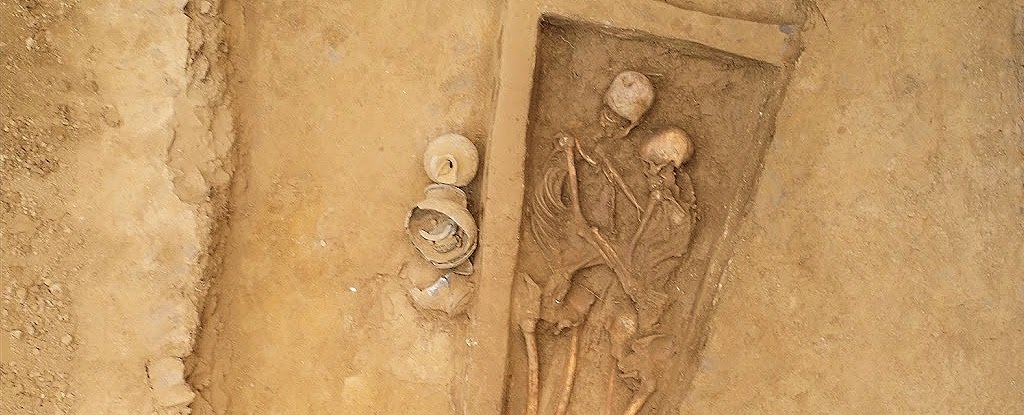
A new study has revealed that the skeletal remains of two lovers were found locked in an eternal embrace more than 1,500 years ago in northern China.
Researchers believe it's possible that the woman who wore a metal band on her left finger sacrificed herself to be buried with her husband.
Although joint male-female burials in China are common, this entwined burial with two skeletons locked in an embrace and a bold display love is unique in China. It may reflect the changing attitudes towards love in China at the time, according to the study's authors.
Qian Wang, a lead researcher in the Department of Biomedical Sciences at Texas A&M College of Dentistry, stated that this is the first time a couple has been found in a loving embrace anywhere in China. He also shared his findings with Live Science via email.
Similar: Photos: An ancient tomb for a Chinese couple revealed
The burial was discovered by archaeologists in June 2020 while excavations were taking place in a cemetery that had been exposed in construction in Shanxi province. The cemetery had 600 burials belonging to the Xianbei, an ancient nomad group from northern China that was assimilated into Han Chinese culture. It was dated to the North Wei Dynasty (386-534 CE), as the grave shapes and ceramic items found in the cemetery showed.
Illustration of the lovers overlayed on a photograph of the burial ground. (Anqi Wang; Qiang Wang)
The unique burial of the couple prompted archaeologists to not fully excavate their skeletal remains. The team kept them tied together so they could be displayed in a museum exhibit.
Wang stated that archaeologists discovered two additional couples buried in the same cemetery. However, these couples did not hug as closely and the females weren't wearing rings.
Partially excavating the ringed lovers revealed much about them. The man was approximately 5 feet 4 inches (161.5 cm) tall. He had some injuries including a broken arm and bone spurs on the right leg. Researchers believe he died between the ages 29 and 35.
However, the woman was quite healthy at the time she died. She was approximately 5 feet 2 inches (157.1 cm) in height and had only a few dental issues, including cavities. She died most likely between the ages 35 and 40.
Wang suggested that it is possible that the woman wore her ring on her ring finger because of influence from "the customs of the western regions and beyond through Silk Roads and assimilation by the Xianbei folks, reflecting the integration Chinese and Western cultures."
The couple were buried with tender care by the person who did it. His left arm was under her body, while his body was bent toward the woman. His right arm reached out to her and his hand rested on her waist. According to the study, the woman's body was in a "position to be hugged," according the researchers. Her head was slightly down, which would have meant that her face would have been on his shoulder. His body was hugged by her arms.
The woman found the ring on her finger. (Qian Wang
This scene is likely to reflect the couple's devotion to each other throughout their lives. The study revealed that the message of the [burial] message was that husband and wife had lied together, and they were embracing one another for eternal love in the afterlife."
There were a few theories by the team about how the couple ended in the same place. The evidence isn't clear that the lovers died simultaneously from violence, poisoning or disease. Researchers speculate that the husband may have died first, and the wife sacrificed her own life so they could be buried together.
It is also possible that the wife died first, and the husband took his own life. However, this seems less likely as the woman appears to be in better health than her spouse.
Similar: Photos: Treasures found in ancient tombs of China dating back to 800-years-old
Are you looking for love?
Researchers found that the cultural norm for expressing and pursuing love in China during the first millennium was when the couple was alive. There are many stories of love, and historical records that show people who took their lives in love. Wang stated that the idea of pursuing love and then dying by suicide was accepted, if not encouraged.
Although the circumstances leading to these lovers' intimate entombment remain a mystery, Wang stated that their burial was a unique display of human emotion of love in burial, giving a rare glimpse into love, life and death.
The study was published online in the International Journal of Osteoarchaeology on June 4.
Similar content:
Images: An ancient mural tomb was discovered in China
Photos: Bronze vessels in an ancient Chinese tomb
Photos: Farong, a 1,500-year-old tomb belonging to a Chinese woman
Live Science originally published this article. You can read the original article here.
